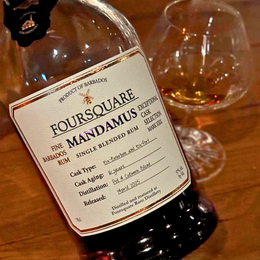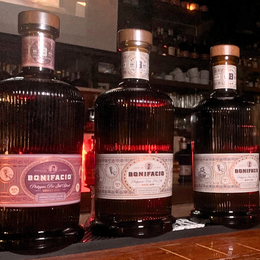
In the realm of Central American rums - rons as they call it - Zacapa has long stood out as being one of the key references of the region. If you were going to get to know Central American rums (one of arguably the three big rum regions and styles - more colloquially known as Spanish style rons), Zacapa is as good as any a place to start.
Interestingly in terms of history, Zacapa certainly can't claim that having been around a whole lot of time has been what's led to its success - it was instead established in 1976 to commemorate the 100th anniversary of the establishment of the eastern Guatemalan town of Zacapa, which lies some 112 kilometres away from the country's capital. The town itself, whose name derives from Aztec to mean "on the river of grass", has a real sense of being rather historic with its old school charm, and walking around the town's square almost feels like stepping into a portal into the past. Elevated to some 225 metres above sea level, the town boasts little in the way of tourist attractions (although it does offer some artisanal cheeses and cigars), and yet itself remains a critical node for Guatemala - Zacapa sits as the junction for the Guatemala City railroad out from neighbouring El Salvador. Yet it is here that the Botran family had decided to build the Zacapa Distillery.


The Botran family are behind another fellow popular Central American rum Botran, which touts a much longer history, going back to 1939, when five Botran brothers had established the Industria Licorera Quetzalteca (later Industrias Licoreras de Guatemala, or ILG), their parents having come over to Guatemala from Spain. As such, the Botran family has inarguably played a big hand in helping to shape the distilling scene in Guatemala, which has all culminated in the creation of Ron Zacapa.
Combining a focused philosophy of expressing the Guatemalan terroir, along with stylish yet evocative packaging (that stylish El Dorado-esque font and a little handwoven petate around the base of the bottle), that of course holds rich and alluring rums that is aged in a storehouse high up in the clouds, and you've got yourself a star.

Zacapa's storehouse.
Nevertheless it's worth digging further into how Zacapa makes its rum because it's rather unique. It first starts with Guatemalan sugarcane harvested from the Retalhuleu fields in South Guatemala, which are known to be mineral rich volcanic soils, which is then pressed once to extract the cane juice that is then simmered down to a thick honey-like consistency which Zacapa calls Sugar Cane Honey. Fermentation is done very uniquely with the use of pineapple yeasts, which further adds to the rum's unique flavours. Finally it is distilled using column stills, as is in the Central American practice.
Once distilled, the rums are brought up 2,300 meters above sea level to Zacapa's ageing cellars, this raises the rums above the clouds where they'll age amidst the cooler and more humid ambient environment. Zacapa has a rather romantic name for an equally romantic setting for its ageing cellars - the House Above The Clouds. Here in highlands of Quetzaltenango of western Guatemala, the rums spend years in the fresh mountain air, married gently with the Sistema Solera method (where the rums are blended by progressively topping up older barrels with younger rums as is done by Spanish Sherry bodegas) under the watch of Master Blender Lorena Vasquez.

Master Blender Lorena Vasquez
And so on this fine evening, we have Master Blender Lorena Vasquez herself down to give a masterclass on Zacapa and its rums - this is of course only made possible by Singapore's premier private members' rum club, The Rum Cartel, who's so kindly organised this event. If you're big on rums, The Rum Cartel is the place to go, because trust me, many a great rums and rum personalities often gravitate to the events organised by the club - no thanks in small part to the very charismatic Monsieur who runs it.
We'll be trying three rums today, the first of which is the Zacapa Edicion Negra. The Edicion Negra is stated as a blend of rums between 6 and 24 years old, and is aged in barrels such as double charred American oak casks.
Let's go!
Rum Review: Zacapa Edicion Negra, 43% ABV

Tasting Notes
Colour: Mahogany
Aroma: Surely heavier and heartier than the Zacapa 23, yet still carrying the same luscious sweetness. It opens with a compelling milk coffee toastiness with vanilla and caramel, deep molasses, and an abundance of baking spices. Burnt orange peel adds a lift, with plenty of dried fruit sweetness from cherries, apricots, and figs. There’s also a faint spice-and-mint freshness weaving through.
Taste: Spiced and more robust in body, with a thicker texture and enveloping warmth. Begins with that sweet-smokiness of light maple syrup, then gradually reveals drier, smokier undertones– of course never reaching the intensity of a heavily charred bourbon or peated Scotch, but leaning toward dryer notes of some dark chocolate and a bit of leather. Richness stays well-integrated and well-balanced, balancing the sweetness with some toasted barrel without either dimension dominating.
Finish: Rather long with fading dried fruit and burnt caramel leads, followed by a subtle smoky edge. More dry oak notes show up with a touch of bitter chocolate, but the edges are softened by rounded woody caramel notes and mellow spice, all carried by a lingering caramelised sweetness.

My Thoughts
It’s a Zacapa with a bit more character. This is certainly richer than the Zacapa 23, yet still retains the inherent smoothness. The structure sets it apart – built upon the extra wood char and that drier, spiced backbone. Its profile might win over bourbon drinkers with its oak-driven character, coffee-toast richness, and hint of smokiness, while still being very approachable. The slight bitterness on the finish feels kind of deliberate. I reckon this would be an excellent candidate for a rum Manhattan since it could complement and enhance the inherent bitterness of the cocktail.

@CharsiuCharlie







